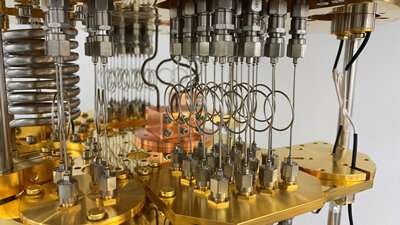Faster technique for resetting quantum circuits proposed

Rebooting a quantum computer is a tricky process that can damage its parts, but now two RIKEN physicists have proposed a fast and controllable way to hit reset.
Conventional computers process information stored as bits that take a value of zero or one. The potential power of quantum computers lies in their ability to process ‘qubits’ that can take a value of zero or one—or be some fuzzy mix of both simultaneously.
“However, to reuse the same circuit for multiple operations, you have to force the qubits back to zero fast,” says Jaw Shen Tsai, a quantum physicist at the RIKEN Center for Quantum Computing. But that is easier said than done.
One of the best current ways to hit reset for qubits built from tiny superconductors is to link the qubit to a photon—a particle of light—in a tiny device called a resonator. The qubit transfers its energy to the resonator, after which the photon in the resonator decays, releasing its energy to the environment. This process causes the qubit state to drop back to the ground state (zero). The trouble with this method is that permanent entanglement to a decaying photon rapidly degrades the qubit’s quality, so that it rapidly ceases to be useful for future operations. “It’s bad for the qubit, whose lifetime becomes short,” says Tsai.
Now, Tsai and his RIKEN colleague Teruaki Yoshioka have devised a simulation to help find a better way of resetting the qubit, without harming it.
Based on their calculations, the pair proposed building a resonator that can be controlled using an additional junction made by sandwiching a superconducting material with an insulator, a normal metal, another insulator and another superconductor. This layered junction is controlled by applying a voltage. While the qubit operation is being carried out, the set-up is tuned so that the photon cannot decay. Only when the operation has been completed do the physicists change the voltage, allowing the photon to release energy. “This adjustable resonator is the key to our proposal,” says Tsai.
The best current lab record for resetting a qubit is 280 nanoseconds, with 99.0% fidelity. “Our simulations suggest we could reset the qubit in 80 nanoseconds, with 99.0% fidelity,” says Yoshioka.
The team is now testing this set-up, which is held at low temperatures using a dilution refrigerator, with promising results. “This device should be very useful if we can implement it in a quantum circuit,” Tsai says.
The research was published in Applied Physics Letters.
A three-qubit entangled state has been realized in a fully controllable array of spin qubits in silicon
T. Yoshioka et al, Fast unconditional initialization for superconducting qubit and resonator using quantum-circuit refrigerator, Applied Physics Letters (2021). DOI: 10.1063/5.0057894
Citation:
Faster technique for resetting quantum circuits proposed (2022, January 21)
retrieved 21 January 2022
from https://phys.org/news/2022-01-faster-technique-resetting-quantum-circuits.html
This document is subject to copyright. Apart from any fair dealing for the purpose of private study or research, no
part may be reproduced without the written permission. The content is provided for information purposes only.
For all the latest Science News Click Here
For the latest news and updates, follow us on Google News.

